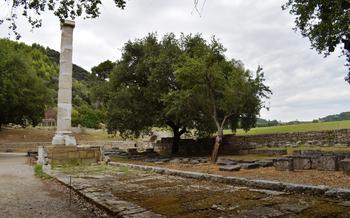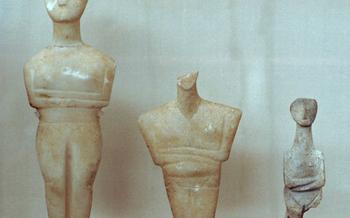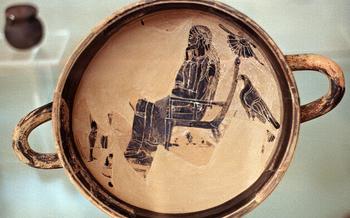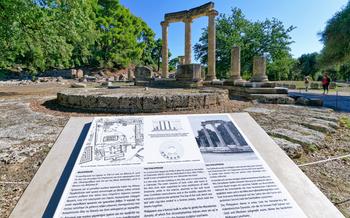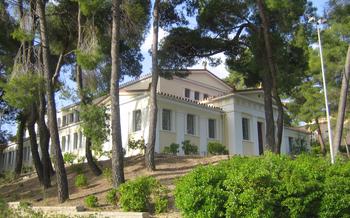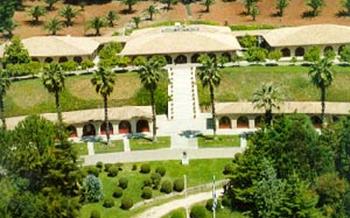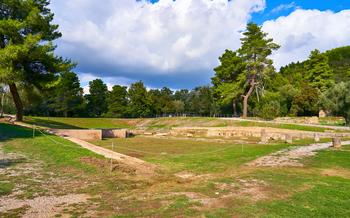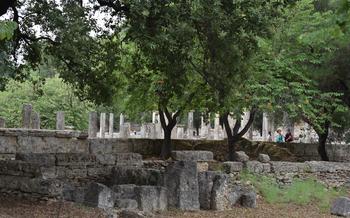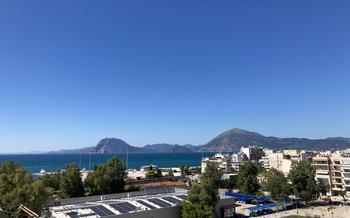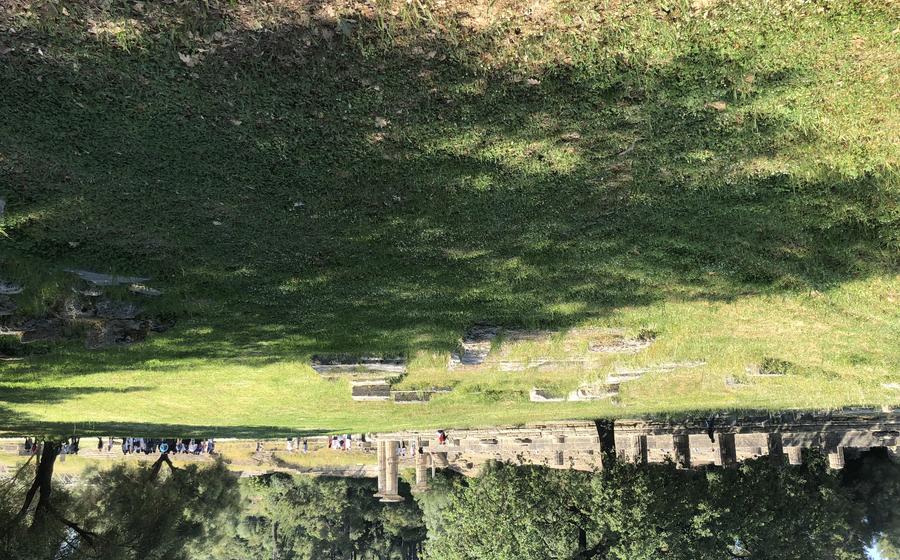
Pelopion
- Olympia: A Journey to Ancient Glory
- Pelopion: Where Heroes Reside
- Witnessing the Power of Zeus
- Unveiling the Secrets of the Treasuries
- Exploring the Ancient Stadium
- Delving into the Bouleuterion
- Admiring the Leonidaion
- Exploring the Echo Colonnade
- Exploring the Philippeion
- Learning from the Archaeological Museum
- Paying Homage to Hermes
- Seeking Guidance at the Oracle of Olympia
- Witnessing the Olympic Flame Ceremony
- Insider Tip: Discovering Hidden Treasures
Olympia: A Journey to Ancient Glory
Olympia, nestled in the picturesque valley of Elis, is a place where history, mythology, and athleticism converge. Its significance in ancient Greece cannot be overstated, as it served as the birthplace of the Olympic Games, the most renowned athletic competition in the ancient world. The archaeological site of Olympia is a treasure trove of ancient ruins, offering a glimpse into the grandeur and glory of this sacred sanctuary.
Must-see attractions in Olympia:
-
Temple of Zeus: Witness the ruins of the colossal Temple of Zeus, once housing the iconic gold and ivory statue of Zeus, one of the Seven Wonders of the Ancient World.
-
Pelopion: Explore the Pelopion, a sacred grove dedicated to Pelops, the mythical king of Elis, where legendary heroes from Greek mythology were believed to be buried.
-
Ancient Stadium: Step into the ancient stadium, where the Olympic Games were held for over a millennium, marveling at its well-preserved design and imagining the roar of the crowd.
-
Archaeological Museum: Delve into the rich history and culture of Olympia at the museum, housing an impressive collection of artifacts, including sculptures, pottery, and bronze statues.
-
Sanctuary of Zeus: Discover the sacred precinct, where athletes, pilgrims, and officials gathered to pay homage to Zeus, the king of the Olympian gods, and witness religious ceremonies and rituals.
-
Echo Colonnade: Admire the Echo Colonnade, a series of columns that create a remarkable acoustic effect, allowing whispers to be heard across the courtyard.
Pelopion: Where Heroes Reside
The Pelopion is a sacred grove located within the sanctuary of Olympia, dedicated to the mythical hero Pelops, who, according to Greek mythology, was the founder and first king of the Peloponnese. The Pelopion was believed to be the burial place of Pelops and other legendary figures from Greek mythology, including Tantalus, Niobe, and Amphion.
Excavations at the Pelopion have revealed the remains of a large circular enclosure, surrounded by a wall and containing a number of funerary monuments. Among these monuments are several tumuli, or burial mounds, which are believed to be the tombs of Pelops and his family. Other notable structures within the Pelopion include an altar, where sacrifices were made to the heroes, and a small temple, dedicated to Pelops.
The Pelopion was a significant religious site in ancient Greece, and was visited by pilgrims from all over the Peloponnese. It was believed that the heroes buried in the Pelopion had the power to grant favors and protect their worshippers. As a result, the Pelopion was a popular destination for those seeking divine assistance.
Witnessing the Power of Zeus
The Temple of Zeus, towering over the sacred site of Olympia, stands as a testament to the grandeur of ancient Greek architecture and the omnipotence of the Olympian god. Built in the 5th century BC, this colossal temple was one of the Seven Wonders of the Ancient World, captivating visitors with its sheer size, intricate design, and awe-inspiring sculptures.
The temple's Doric columns, each measuring over 10 meters in height, supported a massive entablature adorned with triglyphs and metopes. The metopes, carved with scenes from Greek mythology, showcased the masterful skills of ancient Greek sculptors, depicting the battles of the gods and the heroic deeds of mortals.
Inside the temple, a colossal statue of Zeus, crafted from ivory and gold by the renowned sculptor Phidias, sat enthroned. Towering over 12 meters in height, this magnificent statue was considered the supreme masterpiece of ancient Greek art. Zeus, the king of the gods, was depicted seated on a throne, his muscular body radiating power and majesty. The statue's eyes, inlaid with precious stones, seemed to follow visitors as they moved, creating an almost mystical presence within the temple.
Although the colossal statue of Zeus was destroyed in a fire in the 5th century AD, the temple's ruins remain a powerful testament to the architectural prowess and artistic brilliance of the ancient Greeks. Visitors can still marvel at the temple's imposing columns, intricate carvings, and the sheer scale of this once-magnificent structure, gaining a glimpse into the awe and reverence that the ancient Greeks felt for their supreme deity.
Unveiling the Secrets of the Treasuries
The treasuries of Olympia, located in the sacred precinct, served as repositories for offerings and dedications to the gods, primarily Zeus. These structures, built by various Greek city-states, showcased their wealth, piety, and rivalry. Each treasury displayed a unique architectural style, reflecting the diverse artistic traditions of ancient Greece.
The treasuries were typically constructed from limestone or marble and featured intricate carvings and sculptures. They varied in size and design, ranging from small, single-chamber buildings to larger, multi-room structures. Some treasuries were adorned with colorful paintings and mosaics, adding to their visual splendor.
Inside the treasuries, visitors can discover a treasure trove of artifacts and offerings, providing valuable insights into ancient Greek religious practices and craftsmanship. These offerings included precious jewelry, coins, weapons, armor, and statues. Many of these artifacts bear inscriptions or dedications, revealing the names of donors and the reasons for their offerings.
The treasuries also provide a glimpse into the historical context of ancient Greece. The offerings found within them often reflect significant events, such as victories in battle, alliances between city-states, or religious festivals. By studying these artifacts, historians and archaeologists can gain a deeper understanding of the political, economic, and cultural dynamics of the ancient Greek world.
Exploring the Ancient Stadium
In the heart of Olympia, the ancient stadium stands as a testament to the athletic prowess and competitive spirit that defined ancient Greece. Once the stage for the legendary Olympic Games, this awe-inspiring venue continues to captivate visitors with its grandeur and historical significance.
Designed with precision, the stadium's elongated shape and gently sloping track allowed spectators a clear view of the events unfolding within. Constructed entirely of packed earth, the stadium could accommodate an impressive 45,000 spectators, who would gather from all corners of the Greek world to witness the spectacle of the games.
The stadium played host to a variety of sporting events, including footraces, wrestling, boxing, and chariot races. These competitions were not merely displays of physical strength and skill but also held deep religious and cultural significance. Victories in the Olympic Games brought immense honor and prestige to both the athletes and their home cities, solidifying their status within the Greek world.
Beyond the thrill of competition, the stadium served as a sacred space, where athletes and spectators alike paid homage to the gods and sought their favor. Religious rituals and ceremonies were an integral part of the Olympic Games, with athletes making sacrifices and offerings to Zeus and other deities in hopes of securing their support.
Today, visitors to the ancient stadium can still feel the palpable energy of this hallowed ground. Though time has weathered its once-pristine form, the stadium's imposing presence evokes the excitement and grandeur of the Olympic Games, transporting visitors back to an era when athleticism, artistry, and spirituality converged in a celebration of human achievement.
Delving into the Bouleuterion
The Bouleuterion, also known as the Council House, was a significant structure in ancient Olympia, serving as a venue for political and administrative deliberations. Constructed in the 5th century BC, it stood as a testament to the democratic governance of the Olympic Games. The Bouleuterion was a large, rectangular building with a capacity to accommodate over 600 people. Its well-preserved remains reveal an impressive architectural design, featuring a series of stepped seating rows arranged in a semicircular formation. At the center of the Bouleuterion stood a raised platform, where officials and dignitaries would address the assembly.
The Bouleuterion played a crucial role in the decision-making process related to the Olympic Games. It served as a meeting place for the Olympic Council, a body responsible for overseeing the organization and conduct of the games. The council members, known as the Hellanodikai, would gather in the Bouleuterion to discuss and resolve various matters pertaining to the games, including the selection of athletes, the allocation of prizes, and the enforcement of rules and regulations.
In addition to its role in the Olympic Games, the Bouleuterion also functioned as a venue for political assemblies and public gatherings. The citizens of Elis, the region where Olympia was located, would convene in the Bouleuterion to discuss local affairs and make decisions regarding the governance of their city-state. The Bouleuterion thus served as a central hub for political dialogue and decision-making in ancient Olympia.
Admiring the Leonidaion
Amidst the ruins of ancient Olympia, one building stands out for its grandeur and stately presence: the Leonidaion, named after Leonidas, the legendary king of Sparta. This impressive structure served as a guesthouse and a meeting place for distinguished visitors attending the Olympic Games.
Built in the 4th century BC, the Leonidaion is a testament to the architectural prowess of ancient Greece. Its Doric columns, finely carved pediments, and elegant facade exude an aura of power and prestige. Inside, the Leonidaion boasts a spacious hall with multiple rooms, providing ample space for guests to rest and socialize.
The historical significance of the Leonidaion is immense. It played a crucial role in hosting foreign dignitaries and athletes during the Olympic Games. Heads of state, ambassadors, and other prominent figures from across the Greek world congregated within its walls to celebrate the spirit of athleticism and unity.
The Leonidaion stands as a symbol of ancient Olympia's cosmopolitan nature, where people from diverse backgrounds came together to witness the greatest sporting event of the ancient world. Its architectural splendor and historical importance make it a must-see attraction for anyone interested in exploring the rich heritage of Olympia.
Exploring the Echo Colonnade
Nestled amidst the ruins of ancient Olympia, the Echo Colonnade stands as a testament to the architectural ingenuity and acoustic wonders of the ancient Greeks. Located near the Temple of Zeus, this colonnade was constructed in the 4th century BC and served as a gathering place for athletes and spectators during the Olympic Games.
The Echo Colonnade comprises a row of 16 Doric columns, arranged in a semi-circular formation. The columns are spaced in such a way that they create a unique acoustic effect, allowing sounds to reverberate and echo throughout the colonnade. According to legend, if a person stood at one end of the colonnade and whispered against the wall, their words could be heard clearly at the opposite end. This phenomenon is attributed to the precise positioning and curvature of the columns, which act as natural sound reflectors.
Apart from its acoustic properties, the Echo Colonnade is also notable for its architectural beauty. The columns are made of local limestone and feature intricate carvings and moldings. The capitals of the columns are adorned with delicate acanthus leaves, adding a touch of elegance to the structure.
The Echo Colonnade holds a significant place in the history of Olympia. It served as a gathering place for athletes and spectators during the Olympic Games, providing a space for them to socialize, relax, and seek refuge from the sun. The colonnade also played a role in religious ceremonies and rituals associated with the Olympic Games.
Today, the Echo Colonnade stands as a reminder of the ingenuity and creativity of the ancient Greeks. Its unique acoustic properties and architectural beauty continue to fascinate visitors, making it a must-see attraction in ancient Olympia.
Exploring the Philippeion
Erected in the 4th century BC by King Philip II of Macedon, the Philippeion stands as a testament to his military prowess and political influence in ancient Greece. This circular building, constructed from limestone and marble, features a colonnade of 18 Corinthian columns encircling a central cella. The interior of the cella once housed statues of the royal family, including Philip II himself, his wife Olympias, and their son, Alexander the Great.
The Philippeion boasts intricate sculptures and reliefs that narrate the story of the Macedonian dynasty's lineage and achievements. These artworks, crafted by renowned sculptors of the time, depict scenes from Greek mythology, Macedonian history, and Philip II's military triumphs. The building's frieze, in particular, showcases a captivating battle scene between Greeks and Persians, emphasizing the power and glory of the Macedonian army.
Beyond its historical significance, the Philippeion serves as an architectural marvel, showcasing the refined craftsmanship and artistic sensibilities of the ancient Greeks. Its circular design, elegant columns, and intricate sculptures make it a captivating sight to behold. Visitors can marvel at the well-preserved remains of this monument, transporting them back to an era of grandeur and power.
Learning from the Archaeological Museum
The Archaeological Museum of Olympia stands as a treasure trove of artifacts that unveil the rich history and cultural heritage of ancient Olympia. Within its walls, visitors embark on a journey through time, exploring a diverse collection that encompasses religious relics, athletic achievements, and exquisite works of art.
Artifacts from Olympia's sacred past take center stage, including votive offerings, statues of deities, and intricate religious implements. These relics provide a glimpse into the deep devotion and rituals that permeated ancient Greek society.
The museum also celebrates Olympia's athletic legacy. Bronze statues of victorious athletes, inscribed victory lists, and training equipment showcase the rigorous pursuit of physical excellence in ancient Greece. Visitors can almost hear the echoes of cheers and witness the determination of athletes as they strived for Olympic glory.
Artistic masterpieces from Olympia's golden age adorn the museum's galleries. Sculptures, pottery, and jewelry crafted with exceptional skill and artistry offer a testament to the creative genius of ancient Greek artisans.
Interactive displays and educational programs enhance the museum experience, making it accessible and engaging for visitors of all ages. Through hands-on activities, multimedia presentations, and guided tours, visitors gain a deeper understanding of ancient Olympia's significance and its enduring influence on Western civilization.
Paying Homage to Hermes
The Temple of Hermes, situated amidst the sacred grove of Altis, stands as a testament to the veneration of the Olympian gods. Dedicated to Hermes, the messenger of the gods, the temple exudes an aura of divine presence. Constructed in the 4th century BC, this Doric-style temple showcases exquisite architectural features. Its well-preserved facade, adorned with intricate carvings and sculptures, depicts scenes from Greek mythology, narrating the tales of Hermes' cunning and wit.
Inside the temple, visitors can marvel at the awe-inspiring statue of Hermes, crafted from Parian marble by the renowned sculptor Praxiteles. This masterpiece, dating back to the 4th century BC, captures the essence of the Olympian deity with remarkable precision. Hermes is depicted with a serene expression, his cloak gracefully draped over his shoulders, revealing the contours of his muscular physique. The statue's exceptional craftsmanship and attention to detail have earned it a reputation as one of the finest examples of ancient Greek sculpture.
Seeking Guidance at the Oracle of Olympia
Nestled in the heart of the Altis, the Oracle of Olympia was a sacred site where people from all over the ancient world sought guidance and wisdom from the gods. The oracle was believed to be a conduit to the divine, and its pronouncements were revered and respected by both commoners and rulers alike.
To consult the oracle, visitors would first purify themselves in the sacred waters of the Alpheus River. They would then make an offering to the gods, usually in the form of a sacrifice or a valuable gift. Once the offering had been accepted, they would enter the temple of the oracle, where they would pose their question to the priestess known as the Pythia.
The Pythia would then enter a trance-like state, believed to be induced by the intoxicating fumes rising from a chasm in the earth. While in this state, she would utter cryptic and often ambiguous prophecies, which were then interpreted by the priests of the oracle. The responses of the oracle were often vague and open to interpretation, allowing the seekers to find their own meaning and guidance within the words.
The Oracle of Olympia was consulted on a wide range of matters, from personal decisions to political strategies. Its pronouncements were considered to be authoritative and were often used to make important decisions, such as whether to go to war or to establish a new colony. The oracle's influence extended far beyond Olympia, and its reputation for wisdom and guidance made it one of the most important religious sites in the ancient world.
Witnessing the Olympic Flame Ceremony
The Olympic Flame Ceremony holds a profound significance in the realm of sports and global unity. Rooted in ancient Greek mythology and tradition, the ceremony involves the lighting of the Olympic Flame in Olympia, the birthplace of the Olympic Games. This sacred flame symbolizes the spirit of competition, sportsmanship, and the pursuit of excellence.
The ceremony begins with a solemn procession of priestesses, adorned in traditional Greek attire, who gather at the Temple of Hera. Using a parabolic mirror, they harness the sun's rays to ignite the Olympic Flame, a ritual that has been performed for centuries. The flame is then placed in a specially designed torch and embarked on a global journey, carried by torchbearers who relay it across countries and continents.
The Olympic Flame serves as a symbol of hope, unity, and the shared values of the Olympic movement. Its arrival at the host city marks the official commencement of the Olympic Games, igniting excitement and anticipation among athletes and spectators worldwide. The ceremony is a powerful reminder of the enduring legacy of Olympia and its indelible mark on the history of sports.
Insider Tip: Discovering Hidden Treasures
Beyond the confines of Olympia's archaeological site, the allure of the Peloponnese region beckons. Embark on a journey through the picturesque countryside, dotted with ancient ruins and charming villages. Discover hidden gems such as the Temple of Apollo Epicurius, perched majestically atop Mount Kotylion, or the ancient city of Messene, with its remarkably preserved fortifications.
Immerse yourself in the local culture by visiting traditional villages like Stemnitsa and Dimitsana, where centuries-old customs and traditions are still upheld. Indulge in the Peloponnese's culinary delights, savoring regional specialties like grilled octopus, fresh seafood, and the renowned orange pie.
Participate in local festivals that celebrate the region's rich heritage. Witness traditional dances, listen to enchanting music, and savor delicious local cuisine. These festivals offer a glimpse into the vibrant and welcoming spirit of the Peloponnese people.
As you explore this captivating region, you'll uncover a tapestry of history, nature, and culture, making your journey to Olympia truly unforgettable.
